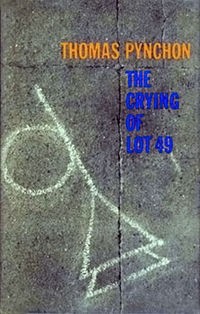Some smart people need to lighten up; if any smart person ever needed to quit lightening up, it’s Thomas Pynchon. Possessed by one of the most awesome writing talents of any living writer, he fills his pages with pop culture references, some of them clever, most of them not.
It’s brilliant when one of the characters in Pynchon’s latest, “”Inherent Vice,”” describes his hometown as a place “”where you always root for Ignatz and not Offisa Pup,”” referring to the great comic strip “”Krazy Kat.”” But I groaned when his characters had a conversation about “”Gilligan’s Island,”” and I groaned even louder when he came up with a connection between Charles Manson and Charlie the Tuna.
But you can’t accuse Pynchon of being predictable. With “”Inherent Vice,”” the reclusive novelist has done something he hasn’t even attempted since his 1966 classic “”The Crying of Lot 49″” — he’s written a novel you can read in an afternoon.
Unfortunately, it’d be a more-or-less wasted afternoon. Whereas “”Lot 49,”” about a bored California suburbanite who stumbles onto what might be an ancient conspiracy involving the U.S. Postal Service (or might just be her sun-fevered imagination at work), is a gorgeous, languid, funny book that lodges itself in your imagination and never leaves, “”Inherent Vice”” reads as if Pynchon has jumped onto a bandwagon with severely worn-out tires.
The bandwagon is that of the fast-paced detective thriller, and “”Inherent Vice”” is Pynchon’s stab at the genre. It appears that Pynchon picked up an armful of cheap paperbacks from the bargain bin at Target, spent a month consuming them, and decided to churn out one of his own.
Pynchon’s setting is late-1960s California and his hero is “”Doc”” Sportello, a perpetually stoned detective who’s so out of it he thinks Sherlock Holmes was a real person. He’s hired by his ex-girlfriend to investigate a case involving her new beau, a notorious real-estate mogul who runs with a rough crowd.
The story glides along for a few chapters in a relatively straightforward way, and is fairly enjoyable for a while. But halfway through the novel, I realized I wasn’t sure how I was supposed to be taking any of this. If it’s a parody, it’s not funny enough, and if it’s meant to be taken straight, it’s not serious enough.
Part of the problem is that Pynchon no longer knows what to leave out of a novel. He’s spent so many years writing oversized tomes packed with frantic, tiring inventiveness that he can’t stop himself from putting in every idea he has, be they good or bad. He buries his plot in Pynchonisms, like those made-up songs he seems to find so hilarious. One of them involves a repo man: “”Good-bye and cheer-i-o/To my ol’ stereo!”” If that sort of thing makes you bust a gut, Pynchon’s your guy.
Another problem is Pynchon’s use of dialogue. I’m tempted to say that no one in history has ever talked like characters in a Pynchon novel. On the other hand, I wasn’t around in the ’60s, so maybe people did say things like this: “”See these shoes I’ve got on? Remember those white loafers that Dr. No wears in Dr. No, 1962? Yes dig it! Same identical ones!”” Including a movie’s date is one thing, but this is the first time I’ve ever seen it attempted in a line of dialogue.
Pynchon also keeps slipping into his habitual narrator’s voice, which makes his fitful attempts to mimic Raymond Chandler’s deadpan style come across as downright embarrassing. “”On certain days,”” he writes, “”driving into Santa Monica was like having hallucinations without going to all the trouble of acquiring and then taking a particular drug, although some days, for sure, any drug was preferable to driving into Santa Monica.””
The vaguely Chandler-ish cadences of this sentence and the fake cynical tone seem intent on reminding us we’re reading a hard-boiled thriller. But the pedantic “”acquiring and then taking,”” the italicized “”any”” and the way the sentence dribbles to a close all remind us that we’re not.
For all that, “”Inherent Vice”” has its moments. Some of Doc’s internal monologues about California life are haunting and well-written (a particularly good one begins on page 98). But from a writer of Pynchon’s caliber, it’s just another candidate for the bargain bin at Target.
Our guide to the work of the mysterious Thomas Pynchon.
V. (1963): Pynchon’s National Book Award-nominated debut about “”human yo-yo”” Benny Profane and a search for the mysterious “”V”” won him a reputation as one of the brightest literary stars of the ’60s.
The Crying of Lot 49 (1966): This slim classic remains Pynchon’s most accessible work, though he later all but disowned it, claiming he’d forgotten most of what he knew about writing before penning it.
Gravity’s Rainbow (1973): The most notoriously hard-to-read book since James Joyce’s “”Finnegans Wake,”” Pynchon’s World War II epic has something to do with rockets, sex and Nazis. It was controversial enough that the Pulitzer Prize committee decided to award no prize at all that year rather than recognize it.
Mason and Dixon (1997): Pynchon took a dive into the annals of American history with this book, which featured the eponymous explorers, a pot-growing George Washington, and a mechanical duck.
Against the Day (2006): Pynchon’s romp about anarchists at the turn of the century was well-received by most critics. Reviewing it at the time, the Daily Wildcat found it “”impressive without being likable.””









